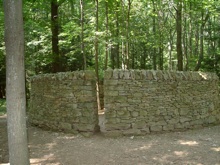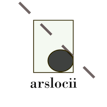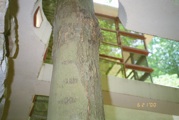arslocii
placeness as art


arslocii
placeness as art
































Quest for artistic endeavor between the Susquehanna and Illinois Rivers
Heading west through Pennsylvania, while crossing the Allegheny Mountains, and coming to where the PA, MD, WV borders nearly become fuzzy, there is an area called the Laurel Highlands. An exquisitely beautiful, rolling, green and mountainous area that is popular among outdoor-sports enthusiasts as well as visualists. Also a haven for the wealthy and their country homes, like the ones that Frank Lloyd Wright was commissioned to build in a couple of choice locations.
Fallingwater
Ohiopyle, PA
So much has been written about this residence, but it didn’t prepare us for the competing beauty of the house and site and how they balance each other so completely. Delicately poised, all horizontals, this unlikely structure in a wooded glen harkens to Fitzcarraldo’s riverboat in the Amazon jungle. Oh, sure, there’s the money shot of the house-as-bridge floating above the waterfall. But there is so much more. The interior of the house is both open and airy, as well as circuitous and unfolding as any two polar opposites could be under one roof. The way the building nestles into a rock-face cliff in the back is almost as mysterious as how it floats in the front. The best floating, though, is the interior stairs that exit out to and hover over the creek at a pooling point right before the falls (think sitting, dangling). And not only are the grand gestures sweeping but the tiny Wright details at every turn, in every room, in every inch of space are humbling. Fallingwater is certainly one of his most successful integrations of the manmade and the natural. But wait....
Kentuck Knob
Chalk Hill, PA
Who knew there were two Wrights within minutes of each other out there? From the bottom of a glen to the top of a knob, this house is more of a fortress than Fallingwater’s terrarium. It faces away from you, looks protective, you might even mistake it for a WPA ranger station if you happened upon it. From the moment you see its unique angle-pattern motif in the frieze beneath the roof line, you know that this is something special. The golden wood and gray stone – heavy, hard materials that breathe – is what you remember; the coziness, the livability (Fallingwater seems more for entertaining), and the lovely captured views from the South Porch. But wait, FLW didn’t situate this house at its most spectacular perch, at the very top of the hill but down a ways from it. Walk behind the house, beyond some lovely terraces and hold on to your breath – walk to the precipice of Kentuck Knob and see what looks like endless mounds of green, other knobs, soul-quenching natural beauty. Just below, there is a gentleman’s farm that couldn’t be more picturesque if it was a painting, a plump, earnest landscape straight out of Thomas Hart Benton. Wright rightfully opted to not compete with this spectacle. If you can pull yourself away from this view, and it isn’t easy to do, the land backtracks and descends behind and beyond the house into meadows and boscs now housing a sculpture collection. There are many British artists represented here – no surprise, since it all belongs to Lord Palumbo (who once also owned the Mies van der Rohe-designed Farnsworth House – see below – where this collection once resided), including two Andy Goldsworthy pieces. Also in residence is a huge chunk of the Berlin Wall and London artifacts like a cupola from an old church and a cluster of red telephone booths. Thanks to the Palumbos for sharing it all. And thanks to FLW for leaving another gift, this one less showy and still beautifully in balance with its surrounds.
Millennium Park Chicago, IL
There may not be in the U.S. another modern public square as impressive as this one. Walking north, you make a seamless segue from Grant Park into Millennium Park, although you know that you have moved into another century. Even with all the glitz and wow of this public playground (as though it were what’s left of a futuristic Worlds Fair grounds), there are things of natural beauty as well. In huge open spaces it isn’t easy to compete, let alone satisfy, but Millennium Park has both the mega stroke and the small gesture. You could probably spend a couple of days there and it would seem like a city unto itself, or maybe the sideshow for the big tent of Chicago. The spaces are well-delineated and equally well-connected: sculpture here, perennial gardens there, a Frank Gehry-designed theater – not only performing venues but people-watching and narcissism-engaging spots all around. One of the many centerpieces is Anish Kapoor’s “Cloud Gate,” a highly reflective flotation-device or bean-shaped form that engages the self-love in all of us, especially the city of Chicago, as it is spectacularly mirrored in the object’s curvature. This piece provides an interesting arslocii dilemma in which art and site interact in a very intimate way, and yet, whether the pairing is inevitable or necessary is in question, and also, whether it is any more meaningful than 3-D funhouse trickery. Perhaps another visit will be required to resolve this issue. The Lurie Garden alone is worth the trip. Basically a prairie garden of natural subtle beauty and texture, it is encased on two sides (caged, protected, transitioned) by tall open metal structures containing densely planted large shrubs, called the Shoulder Hedge – providing a segue between the more built elements of the park and the planted garden, but also creating a half-living/half-manufactured design element. Move over, Thomas Church.
Farnsworth House
Plano, IL
This house, designed by Ludwig Mies van der Rohe, is a non-native invasive in its simple riverside setting. And that would be just fine with modernist Mies. It is unforgivingly minimal in design and lovely in contrast to its context, although Mies would not care a wit about the relationship. It’s difficult to imagine living comfortably in something akin to a fish tank, but it would be almost impossible to find an unnecessary element in its bare-bones presentation. The materials used in the interior, wood and travertine, add a simple beauty and warmth to a sketch of positive space, leaving a kind of negative space to be filled. But that also works for the exterior to good effect. It is a death-defying dance between man and nature, but they manage to coexist so well – one forcing the other to recognize its best attributes. Despite the fact that the clever design of its floating is a result of practicality, in that the Fox River floods frequently, the proportions of the lift from the ground and the size of the terrace all interplay to create a theatrical result – a magic-carpet playhouse in the woods. In comparison to Philip Johnson’s Glass House, there is no comparison. Farnsworth levitates whereas Glass sits clunkily, ham-fisted on the ground. If you are within striking distance of this isolated burg called Plano, the home of the McCormick Harvester in the heart of farm country, driving through fifty miles or so of rolling fields, the Farnsworth is a must-see diamond in the rough.
Effigy Tumuli
Ottawa, IL
Michael Heizer has been a land artist for forty years. Much of what he has done has been ambitiously large scale and often reckless with the land. This piece is his environmentally conscious one, commissioned in 1983 by the Ottawa Silica Company Foundation. A land reclamation project to restore the acid soil damaged by strip-mining for coal and to stop erosion, the site sits on a bluff overlooking the Illinois River. Five mounds or tumuli, some built up to 18’ high, and formed in the shapes of a snake, a catfish, a turtle, a frog and a water strider, pay homage to the Native Americans who once inhabited the land and to the indigenous animals who shared it with them. Completed in 1985, the site is now twenty-some years into its regeneration and the forms of the animals are now mostly indistinct. The most striking thing about it is the bizarre quality of the landscape, still. Not dissimilar from a desert: dry, pale, sandy soil; grassy, scrubby, patchy growth; no trees, no shade. During a hot walk on the 1.5-mile trail in and among the mounds, you get a real sense of what a dead environment is (although this is improved from what man’s industry had made it). There is a place near the midpoint where you can see the remnants of the mining – pink, chalk-like geometricised cutaways of an entire cliff face; you might think this is another planet. When you look down 90 feet on the other side of the bluff there is the river valley with its green banks. The contrast is eye-opening. This is worth seeing for, if nothing else, the lesson you learn.
Nathan Manilow Sculpture Park
University Park, IL
Another interesting landscape is the “wild prairie swales” at Governors State University campus. Across the 750 acre prairie site are a couple of dozen large-scale works, some by well-known artists. The quality of the pieces is generally good but, once again, it is the setting that enhances the art. Somebody (somebody who’s visited Storm King, no doubt) mows these swaths throughout the grounds, creating paths among the high grasses and wildflowers, and also encircling the artworks. There is an illusion of the pieces being carved right out of the landscape as the landscape is carved out to connect the pieces. The visual result is that every sculpture becomes a kind of crop circle. You walk through these cuts as if you were working your way through a corn maze or the poppy field on the way to Oz or, perhaps, the parting of the Red Sea (pick your metaphor). The effect is enchanting, theatrical, and adds to the mystique of the artworks. Martin Puryear’s “Bodark Arc” was undergoing a reconstruction at the time of our visit. Despite the upheaval, this site-specific commissioned artwork is very much involved with its setting, using the natural features of the site cleverly as elements of the design and forcing the viewer to move around the piece on its own pathway like a kind of labyrinth arc. Another special pairing is Jene Highstein’s “Flying Saucer,” which appears at the top of a small hillock after you have “tunneled” through the high grass. It looks as if it has spun down to its perch in a dramatic landing, creating the void in the grasses in a perfect circle around it. The art and its setting seem exactly where and how they should be, and we cannot imagine a more perfect union. The land at the Manilow has a different quality from the lush greenery of river valleys; it is slightly rolling, providing good prospects for the sculptures with a variety of vantage points, but it is the grasses (not lawns) that you travel through that enclose you and then open up to the next view of art that is entrancing. Somebody here has a different idea of presentation, art and environment, and it is a rare and enjoyable find.
1933 World’s Fair Homes of Tomorrow
Beverly Shores, IN
The vision of six houses being moved by barge across Lake Michigan in 1935 is hard to shake. Thank goodness developer Robert Bartlett had enough greed and moxie to do it, placing these salvaged treasures of futuristic thinking in a safe place, the Indiana Dunes National Lakeshore. Now a part of the historic Century of Progress Architectural District, the houses sit, although a bit worse for wear, mascots of a more future-thinking time. Each is unique and iconic. And they all wait in their dune-scape terraced beachfront property like Easter Island statues staring out to Canada, or somewhere further, across the vast timeless lake, perhaps contemplating from whence they came. The original concept from The Home Planning Group at the Exposition was to explore modern conveniences, building materials and techniques. As far as the present-day future is concerned, the materials and construction methods didn’t fare all that well. But the designs of the buildings are still as viable and as appealing, and maybe as strange, as they were seventy-five years ago to Fair attendees. Now, instead of being the 3-D billboards for corporations inspiring the needs and wants of a burgeoning consumer-based society on the move, they are souvenirs of the past and, happily, their future persists. The idea of them being arranged literally on the up- and down-sides of sand dunes is reflective, figuratively, of their three-quarters-of-a-century personal journey of survival and relevance.
arslocii, a creation of Probasco Haus Press
copyright © 2010 Probasco Haus Press LLC













Top: Kentuck Knob’s South Porch.
Bottom: “Room,” by Andy Goldsworthy, Kentuck Knob.
Right: Farnsworth House, view of entrance and living room.







